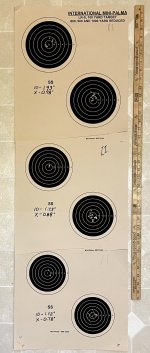Hey gang. Running into something very curious.
Scenario:
Indoor, about 80º F, no wind
MkII FVSR Suppressed, 4.5-27x Athlon Eres BTR Gen 2, Boyd's Varmint Stock
CCI SV 1070fps 40gr
Bipod & Rear Bag
Situation:
I can consistently hit sub-moa groups at up to 80 yards indoor. However, once i get the target to 100y (i haven't tried 81-99 yards)
Below are pics of 75 yards x 10 shots and 100 yards x 5 shots (because more shots wouldn't change anything for proof of concept).
Any Idea what the issue is here? Is it ammo? Are there some recommendations you would make for better choices? Not necessarily looking for one right answer, but more of a discussion on the ballistics (of course recommendations are helpful too!).
It looks like the rounds are opening up widely at 100 yards vs 75 yards.
Thanks in advance!
EDIT: Thanks to all the good info here. I'm now seeing a lot of threads showing my exact scenario. My conclusion is that CCI SV just won't perform to what I think it should at 100 yards. It appears I would need a HV load (or better match load SV) for > 100y, and SV for < 100 y.
75 yards x 10 shots

100y x 5 shots

Scenario:
Indoor, about 80º F, no wind
MkII FVSR Suppressed, 4.5-27x Athlon Eres BTR Gen 2, Boyd's Varmint Stock
CCI SV 1070fps 40gr
Bipod & Rear Bag
Situation:
I can consistently hit sub-moa groups at up to 80 yards indoor. However, once i get the target to 100y (i haven't tried 81-99 yards)
Below are pics of 75 yards x 10 shots and 100 yards x 5 shots (because more shots wouldn't change anything for proof of concept).
Any Idea what the issue is here? Is it ammo? Are there some recommendations you would make for better choices? Not necessarily looking for one right answer, but more of a discussion on the ballistics (of course recommendations are helpful too!).
It looks like the rounds are opening up widely at 100 yards vs 75 yards.
Thanks in advance!
EDIT: Thanks to all the good info here. I'm now seeing a lot of threads showing my exact scenario. My conclusion is that CCI SV just won't perform to what I think it should at 100 yards. It appears I would need a HV load (or better match load SV) for > 100y, and SV for < 100 y.
75 yards x 10 shots
100y x 5 shots
Last edited:





